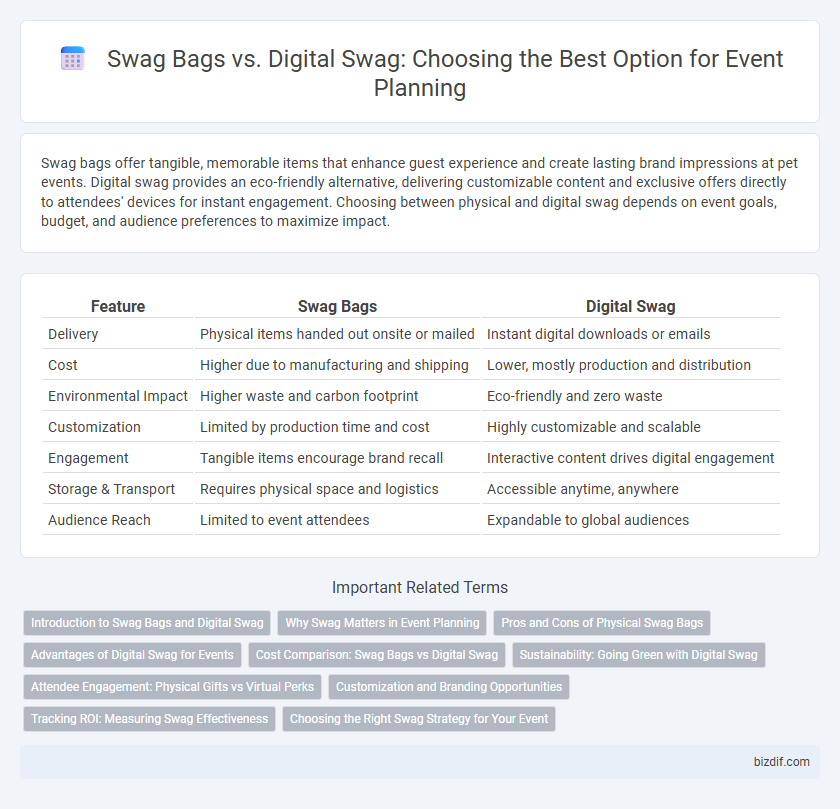Swag bags offer tangible, memorable items that enhance guest experience and create lasting brand impressions at pet events. Digital swag provides an eco-friendly alternative, delivering customizable content and exclusive offers directly to attendees' devices for instant engagement. Choosing between physical and digital swag depends on event goals, budget, and audience preferences to maximize impact.
Table of Comparison
| Feature | Swag Bags | Digital Swag |
|---|---|---|
| Delivery | Physical items handed out onsite or mailed | Instant digital downloads or emails |
| Cost | Higher due to manufacturing and shipping | Lower, mostly production and distribution |
| Environmental Impact | Higher waste and carbon footprint | Eco-friendly and zero waste |
| Customization | Limited by production time and cost | Highly customizable and scalable |
| Engagement | Tangible items encourage brand recall | Interactive content drives digital engagement |
| Storage & Transport | Requires physical space and logistics | Accessible anytime, anywhere |
| Audience Reach | Limited to event attendees | Expandable to global audiences |
Introduction to Swag Bags and Digital Swag
Swag bags traditionally include physical branded items like apparel, gadgets, and promotional materials that enhance attendee experience and brand recall at events. Digital swag offers downloadable assets such as e-gift cards, exclusive content, or app-based rewards that provide eco-friendly and easily accessible alternatives. Both swag bags and digital swag play critical roles in event marketing by increasing engagement and creating memorable interactions for participants.
Why Swag Matters in Event Planning
Swag bags create tangible value by offering attendees memorable, physical items that enhance brand recognition and foster positive associations. Digital swag leverages technology for eco-friendly, customizable giveaways that extend engagement beyond the event through apps, downloads, or online vouchers. Prioritizing swag in event planning boosts attendee satisfaction and drives long-term marketing impact through personalized, memorable experiences.
Pros and Cons of Physical Swag Bags
Physical swag bags offer tangible, memorable items that create a lasting impression and enhance attendee satisfaction at events. However, they involve higher costs for production and shipping, contribute to environmental waste, and can be logistically challenging to distribute and manage. Despite these drawbacks, physical swag bags provide a sensory experience and brand visibility that digital swag may lack.
Advantages of Digital Swag for Events
Digital swag offers eco-friendly advantages by reducing waste and eliminating the need for physical materials, aligning with sustainable event practices. It enables immediate delivery and personalized content, enhancing attendee engagement through tailored experiences and interactive elements. Cost efficiency is improved as digital swag eliminates production, shipping, and storage expenses, allowing event planners to allocate budgets more strategically.
Cost Comparison: Swag Bags vs Digital Swag
Physical swag bags often incur higher costs due to expenses like bulk purchasing, shipping, and packaging, whereas digital swag eliminates these overheads by delivering virtual gifts or discount codes electronically. Investing in digital swag can significantly reduce logistical expenditures and waste, making it a budget-friendly alternative for large-scale events. Event planners seeking cost efficiency typically find digital swag to be a scalable solution with measurable ROI and minimal distribution costs.
Sustainability: Going Green with Digital Swag
Choosing digital swag over traditional swag bags significantly reduces environmental impact by eliminating single-use plastics, paper waste, and excess packaging. Digital swag promotes sustainability through eco-friendly alternatives such as downloadable content, virtual gift cards, and exclusive online experiences, minimizing carbon footprints associated with shipping and production. Event planners investing in digital swag demonstrate corporate social responsibility while enhancing attendee engagement in a green, cost-effective manner.
Attendee Engagement: Physical Gifts vs Virtual Perks
Swag bags featuring tangible items like branded merchandise and samples create lasting sensory impressions that boost attendee engagement by offering hands-on interaction. Digital swag, including downloadable content and exclusive online experiences, enhances engagement by providing immediate, convenient access and personalized digital perks. Combining physical gifts with virtual perks maximizes overall attendee participation and satisfaction through a multi-channel engagement strategy.
Customization and Branding Opportunities
Swag bags offer tangible customization through physical products like branded apparel, accessories, and promotional items that create lasting brand impressions. Digital swag leverages personalized virtual gifts, such as e-gift cards, downloadable content, and branded experiences, maximizing reach and eco-friendly appeal. Both options enhance branding opportunities by tailoring designs and messaging to the event's theme and audience preferences, driving engagement and memorable brand exposure.
Tracking ROI: Measuring Swag Effectiveness
Tracking ROI in event planning reveals that physical swag bags provide tangible engagement metrics through redemption rates and brand visibility at events. Digital swag offers enhanced data collection capabilities, including click-through rates and user interaction analytics, allowing precise measurement of audience response. Combining both methods can optimize swag effectiveness by balancing physical presence with actionable digital insights.
Choosing the Right Swag Strategy for Your Event
Selecting the right swag strategy for your event depends on factors like audience preferences, budget, and event format. Physical swag bags deliver tangible value and enhance brand recall through items such as branded merchandise, while digital swag offers cost-effective, eco-friendly alternatives like downloadable content, promo codes, and virtual experiences. Evaluating attendee engagement goals and logistical considerations ensures your swag strategy maximizes impact and aligns with overall event objectives.
Swag bags vs Digital swag Infographic

 bizdif.com
bizdif.com